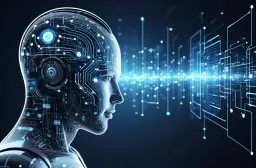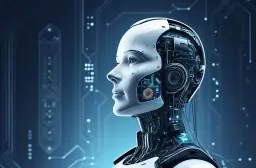AI Pendidikan: Transformasi Digital di Sekolah Masa Depan

Table of Contents
Imagine stepping into a classroom where artificial intelligence (AI) guides every lesson, adapts to each student’s needs, and helps teachers identify the most effective ways to engage their students. This vision of AI in education is quickly becoming a reality as schools worldwide look for innovative ways to integrate technology into the learning experience.
With the rapid advancements in AI, educational institutions are beginning to harness the power of intelligent systems to create smart classrooms, personalized learning paths, and even automate grading. But what does this mean for the future of learning? How will AI reshape the very way we approach education? Are we ready for a revolution in the way we teach and learn?
These questions push us to reflect on the broader implications of AI in the classroom. From personalized learning to smarter, data-driven education systems, the integration of AI is transforming the future of education as we know it. In this article, we will explore the transformative potential of AI in schools, its benefits, and how it is reshaping educational experiences around the globe.
The Rise of AI in Education

The introduction of AI in education is not just a trend, it’s a significant shift in how we approach learning. AI is rapidly transforming traditional classrooms into interactive, adaptive learning environments. This transformation has been fueled by advancements in machine learning, which allows computers to analyze vast amounts of educational data and personalize the learning process for each student.
AI-powered educational tools, such as intelligent tutoring systems and adaptive learning platforms, are becoming integral parts of modern classrooms. These technologies offer tailored learning experiences that meet the individual needs of students. Instead of a one-size-fits-all approach, AI in education helps customize lessons based on a student’s strengths, weaknesses, and pace of learning. This results in a more engaging and effective learning experience.
Personalized Learning Through AI
One of the most significant benefits of AI in schools is its ability to provide personalized learning. AI can analyze a student’s progress in real-time, offering recommendations or changing the course of the lesson based on the learner’s performance. This adaptive learning system ensures that students receive the right level of challenge and support, improving their understanding and retention of the material.
- Tailored Content: AI helps design learning content that is suited to a student’s individual learning style and abilities.
- Real-Time Feedback: Students receive immediate feedback on their work, helping them understand mistakes and learn from them quickly.
- Individual Learning Paths: AI creates personalized learning paths that adjust in real-time, enabling each student to learn at their own pace.
These features allow for smarter classrooms, where teachers can focus more on facilitating discussions and guiding students through complex topics rather than spending time on administrative tasks.
AI-Based Education Tools Revolutionizing the Classroom
The rise of AI-powered teaching tools has paved the way for smarter educational systems. These tools help both students and teachers by automating various aspects of the learning process, from grading to content creation and more.
- Automated Grading Systems: AI-powered grading systems can automatically evaluate assignments, quizzes, and essays. This automation not only saves teachers a considerable amount of time but also provides instant feedback to students, promoting a more dynamic learning environment.
- Intelligent Tutoring Systems: These systems use AI to simulate a personal tutor, providing students with additional help when they need it. These systems can assess the strengths and weaknesses of individual students and deliver targeted learning experiences.
- Data-Driven Insights for Teachers: Teachers can use AI-powered platforms to gain insights into student performance. These systems analyze data from tests, assignments, and activities to help teachers understand where students are struggling and how to improve their instruction.
AI-based education tools are not only transforming how students learn but also how teachers teach, enhancing the overall educational experience.
Cognitive Computing in Education
Cognitive computing in education uses AI to simulate human thought processes, helping students engage with educational content more deeply. By leveraging cognitive computing, we can develop systems that enhance decision-making, problem-solving, and critical thinking skills in students.
These systems are designed to:
- Mimic Human Thought: AI helps replicate the way human brains process information, fostering deeper understanding and retention.
- Enhance Learning Experiences: Cognitive computing allows for interactive simulations, virtual learning assistants, and immersive experiences that encourage students to think critically and independently.
This type of AI is particularly useful in smart education systems that require students to engage with complex tasks and activities that stimulate higher-order thinking.
AI-Driven Curriculum and Virtual Learning Assistants

AI’s integration into curriculum design is changing how learning materials are created and delivered. AI can analyze trends, learning outcomes, and students’ needs to develop AI-driven curricula that are tailored to the evolving educational landscape.
Moreover, virtual learning assistants powered by AI are becoming more prevalent. These digital assistants offer students personalized help, answering questions, providing study materials, and assisting with homework. For educators, AI-driven tools assist with managing classroom dynamics, providing recommendations on teaching strategies based on individual student needs.
The Role of AI in E-Learning
With the advent of e-learning, AI is becoming a vital tool for creating digital education solutions that enhance remote learning. AI systems track students’ progress, assess their knowledge gaps, and suggest resources to help them improve.
Benefits of AI in e-learning include:
- Enhanced Engagement: AI-powered platforms offer interactive content that keeps students engaged and motivated.
- Personalized Learning Experience: Students have access to self-paced learning materials, and AI recommends relevant content based on their performance.
- Efficient Learning Pathways: AI identifies the best learning strategies and resources to help students achieve their goals.
Virtual classrooms and AI-driven e-learning systems are also making education more accessible, especially for students in remote areas.
Overcoming Challenges in AI Adoption in Schools
Despite the vast potential of AI in education, there are still several challenges that schools face when adopting these technologies. One of the most significant hurdles is the cost associated with implementing AI systems. Schools need to invest in both hardware and software to deploy AI effectively.
Another challenge is data privacy and security. With AI systems analyzing vast amounts of personal data, it’s crucial to ensure that student information is protected from misuse or cyberattacks. Schools must also ensure that AI systems are transparent and fair, avoiding biases that could impact educational outcomes.
Training Teachers for AI Integration
For AI to be truly effective in the classroom, teacher training is essential. Educators must be equipped with the skills and knowledge to use AI tools effectively. This involves not only understanding how AI works but also how to integrate it into lesson plans and student interactions.
FAQs About AI in Education
What is AI in education?
AI in education refers to the use of artificial intelligence technologies to enhance teaching and learning processes. It includes tools like intelligent tutoring systems, adaptive learning, and data-driven insights to improve education outcomes.
How does AI benefit students in the classroom?
AI benefits students by offering personalized learning experiences, real-time feedback, and smarter content delivery. It adapts to the individual needs of each student, helping them progress at their own pace.
Is AI replacing teachers?
AI is not meant to replace teachers. Rather, it supports teachers by automating administrative tasks, offering insights into student performance, and providing personalized learning experiences. Teachers remain essential for guiding students and facilitating learning.
What are the challenges of AI in education?
Some challenges include the high cost of implementing AI technologies, ensuring data privacy and security, and training teachers to effectively use AI tools in the classroom.
Conclusion
AI is undeniably transforming the future of education. From personalized learning to automated grading and AI-powered teaching tools, the potential of AI in education is vast. By embracing these technologies, we can create smarter classrooms that provide students with the resources and support they need to succeed. However, as with any technological advancement, challenges like cost, data privacy, and teacher training must be addressed to ensure the successful integration of AI in schools.
Key Takeaways:
- AI is revolutionizing education by creating personalized learning experiences.
- Smart classrooms and AI-powered teaching tools are enhancing educational outcomes.
- Despite its potential, there are challenges such as cost and data privacy that need to be addressed.
- The future of education is one where AI-driven systems help both teachers and students achieve better results.
Popular Tags
ADS SPACE HERE


